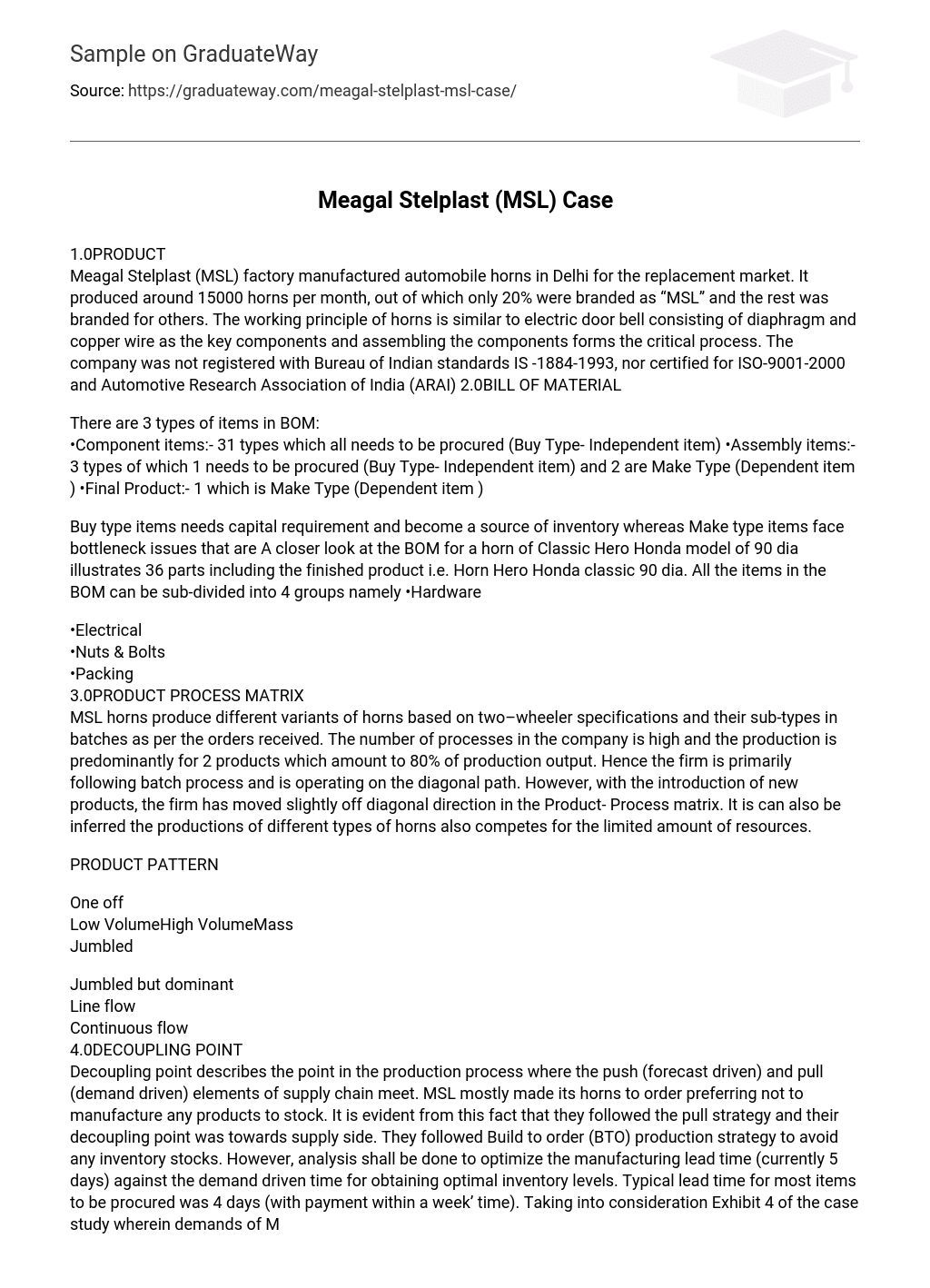PRODUCT
The Meagal Stelplast (MSL) factory in Delhi specializes in manufacturing automobile horns for the replacement market. On a monthly basis, they produce approximately 15,000 horns, with only 20% of them being branded as “MSL”. The remaining majority is branded for other companies. The working principles of these horns closely resemble those of an electric doorbell, incorporating essential components like a diaphragm and copper wire. The assembly process for these components is critical. It is worth noting that the company is not registered with the Bureau of Indian standards IS-1884-1993, nor is it certified for ISO-9001-2000 or the Automotive Research Association of India (ARAI).
BILL OF MATERIAL
Three types of items exist in the BOM.
- Component items:- 31 types which all needs to be procured (Buy Type- Independent item)
- Assembly items:- 3 types of which 1 needs to be procured (Buy Type- Independent item) and 2 are Make Type (Dependent item )
- Final Product:- 1 which is Make Type (Dependent item )
Buying items require capital and become inventory, while making items face bottleneck issues. Taking a closer look at the Bill of Materials (BOM) for a horn of the Classic Hero Honda model with a diameter of 90, it shows 36 parts including the finished product, which is the Hero Honda classic 90 dia horn. All the items in the BOM can be divided into four groups.
- Hardware
- Electrical
- Nuts & Bolts
-
Packing
PRODUCT PROCESS MATRIX
MSL horns manufactures various types of horns for two-wheelers in specific batches, according to the received orders. The company has a large number of processes, with the majority of production focused on two products, which make up 80% of the total output. As a result, the company primarily utilizes a batch process and follows a diagonal path in the Product-Process matrix. However, the introduction of new products has slightly shifted the company’s direction away from this diagonal path. It can also be deduced that the production of different horn types competes for limited resources.
DECOUPLING POINT
Decoupling point is the meeting point in the production process where the supply chain’s push (forecast driven) and pull (demand driven) elements converge. MSL primarily produced horns based on orders, opting not to stock any products. This clearly indicates their adherence to the pull strategy, with their decoupling point being towards the supply side. They implemented a Build to Order (BTO) production strategy to minimize inventory stocks.
However, the manufacturing lead time (currently 5 days) needs to be analyzed in order to optimize it against the demand driven time and achieve optimal inventory levels. In most cases, the lead time for procuring items was 4 days, with payment to be made within a week. By referring to Exhibit 4 of the case study, which lists the demands for MSL horns for January 2012, it can be observed that almost all products can be classified into 7-8 types. The demands for these types are also listed below:
PRODUCT QUALITY & STANDARDIZATION
MSL has consistently produced high-quality products by using superior quality raw materials, specifically opting for an optimal quantity of copper compared to its competitors. It is worth mentioning that MSL is diligent in honoring warranty claims from customers, which typically amounts to 10% of the products produced. Additionally, MSL horns have made investments in automation devices such as coil winding machines, fastening machines, and test benches, but they have not been utilized in the manufacturing process.
Policies of the organisation
- INTERNAL. MSL follows a Made to Order policy as has been specified above. This strategy is mainly adopted owing to inconsistent demands of horns. Another reason for adopting MTO policy was that company didn’t want to manufacture anything to stock due to erratic prices of tungsten and copper. MSL wanted to become a supplier of horns to the Original Equipment Manufacturers (OEMs) of automobiles apart from catering to the replacement market.
- EXTERNAL. MSL produced 15000 horns per month of which only 20% were branded as “MSL”. The rest of the horns were manufactured for others who sold them under their own brand names. The usual price for MSL horn was Rs. 150 which was sold through several wholesalers and workshops. The payments were received within 60 days of supply.
- ORGANIZATION STRUCTURE. MSL was started by Mr. Anil Kishore in Mahipalpur, Delhi. The land was owned by his family. There were 12 workers in the factory including two skilled testers. It doubled its manpower in 2011 prior to which it had only six workers. The newly hired workers were paid on a piece rate basis while the older workers were paid monthly wages. Workers who were paid on piece rate basis were more efficient. MSL had cordial relations with the employees and had amongst the lowest attrition rates compared to other competitors. The supervisory and marketing staff was all like family members.
- WORK TIMINGS. The plant worked 26 days in a month, nine hours per day. The workmen had a lunch break of 30 minutes and two tea breaks of 10 minutes. Overtime of around three hours per day was normal especially post-monsoon seasons which were particularly busy





